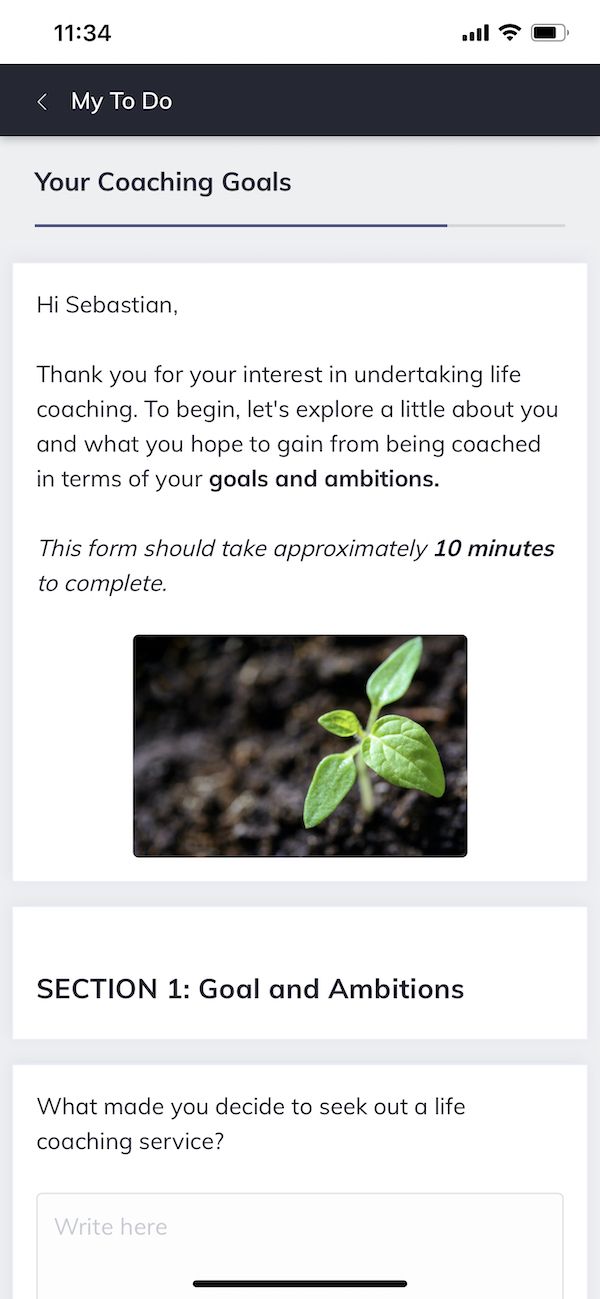

When planning your annual family vacation, you can already visualize the route you will take.
You see the road ahead and the pit stops, and you see yourself arriving at your destination.
The kids pile out of the car, racing to be the first to splash into the sea. It comes naturally, since you have taken this trip many times before.
As professionals, we may not always consider our way of preparing for sessions as planning since it is something that we naturally do.
Yet planning and having a rough outline of the conversation you will have with your coachee are essential pieces of guiding them to achieve their goals.
This article will provide you with several ideas on how to structure your coaching sessions, useful tips for planning your sessions, and specific examples of successful coaching conversations.
Before you continue, we thought you might like to download our three Goal Achievement Exercises for free. These detailed, science-based exercises will help you or your clients create actionable goals and master techniques to create lasting behavior change.
Structuring coaching sessions is beneficial for clients and provides the coach with a clear outline to keep them organized and focused on achieving the client’s objectives.
One of the most widely known models used in various types of coaching is the GROW model (Whitmore, 1988). Our GROW Coaching Model article provides an outline of this popular model, as well as a selection of tools and coaching techniques to integrate into your practice.
While having structure is important, it is also essential to understand how the coaching structure benefits both yourself and your client. One of the most effective ways to do this is through questioning.
Asking good coaching questions is at the heart of effective coaching, regardless of the model that the coach uses. All coaching approaches use questioning in various forms to help uncover individual thought processes (McMahon, 2021).
The coach can stimulate thinking and turn ideas into actions by using five key questions (Barlow, 2005) . The five questions can be asked in order, based on the difficulties and topics the coachee wants to discuss, as the ultimate goal is to get them where they need to go.
Ask the client about their history, such as education, previous work experience, or even their personal experiences that have led them to this point. It builds rapport and creates space for the coachee to feel comfortable. By establishing a history, they can pinpoint where they want to go in the future.
Exploring the present situation is key to understanding why and how the coachee wants to engage in self-improvement. This can also be done by asking your client about their general state of mind (i.e., what they are thinking and feeling; Nawalka, 2020).
By understanding their trajectory and where they are coming from, the coach is better able to meet the client’s needs.
Once the present situation has been explored, this question can help the coachee visualize what they want to achieve. We also consider this the breakthrough point of the session, where the coach should be at their most present, engaging the client in questions that force them out of their comfort zone and create the internal shift they need to move forward (Nawalka, 2020).
Powerful questions are open ended and cannot be answered with a simple “yes” or “no.” A way to ask open-ended questions is to start with one of the following statements (Evercoach, 2020):
Asking open-ended questions guides coachees to come to realizations on their own, rather than toward the answer you think they should pursue.
A lot can happen in the silence between the questions you (the coach) are asking and the coachee’s responses, as they are processing what you are asking them and making connections within their subconscious (Evercoach, 2020).
After identifying where they want to be, the coachee may have trouble figuring out how they want to get there. This is often when the learner really wants advice from the coach but can be assisted to think through the alternatives and options that they might use.
Going through each option or playing through the plausible scenarios helps them select the counseling approach they are most comfortable with (Barlow, 2005). Alternatively, the coachee may choose to play through the riskiest option first as rehearsal with their coach so they can develop the courage to go outside their comfort zone and achieve their goals using a method they may not have considered before.
This last step asks for the learner to examine how they would measure their learning and decide if they have achieved the learning goals they set for themselves. It can also help clarify what actions to take and the method they will use (Barlow, 2005).
This final section is also referred to as the “takeaway,” where the coachee can reflect on what they need to do next and whether they learned or discovered anything new during the session (Evercoach, 2020).
If the coachee is having trouble identifying anything concrete, they can also reflect on how they are feeling after the session, as this will still be helpful in moving them forward.

When planning your sessions, it is important to first understand the coachee’s needs.
To achieve this, the coach should structure the first session around developing a connection with their coachee.
While it is important to prioritize the coachee’s goals, it is difficult to understand their objectives without making them feel emotionally comfortable.
The “where have you been?” and “where are you now?” questions from Barlow’s (2005) model are good questions to establish a baseline.
One strategy coaches can use to help clarify their clients’ goals is to invite them to complete a short, standardized questionnaire prior to their first coaching session.
This can give clients the space to carefully consider their coaching goals without the fear of being judged or the distraction of any anxieties or nerves about their first session.
Quenza (pictured here) is a great tool for the job. It features a simple drag-and-drop activity builder that allows coaches to design a range of questionnaires and activities that clients can complete on their handheld devices.
Using the tool, coaches may also design the check-in surveys for completion throughout the coaching relationship. These can give clients the opportunity to express how they feel they are progressing toward their goals, provide feedback, or indicate what they’d like to discuss in their upcoming sessions.
After establishing an understanding of the coachee’s motivations, it is time to understand each goal and work through how the coachee will go about achieving them.
Goals provide a basis for planning, guidelines for decision making, and justification for actions taken. It is worth stressing that the realization of the coachee’s goal often consists of particular actions that require particular behaviors (Dolot, 2017).
Goals can be set using a variety of different theories and goal-setting methodologies, depending on what your coachee wants to work toward. Our article on goal setting has 20 templates you can explore and use when helping the coachee identify and break down their objectives.

These detailed, science-based exercises will help you or your clients create actionable goals and master techniques for lasting behavior change.